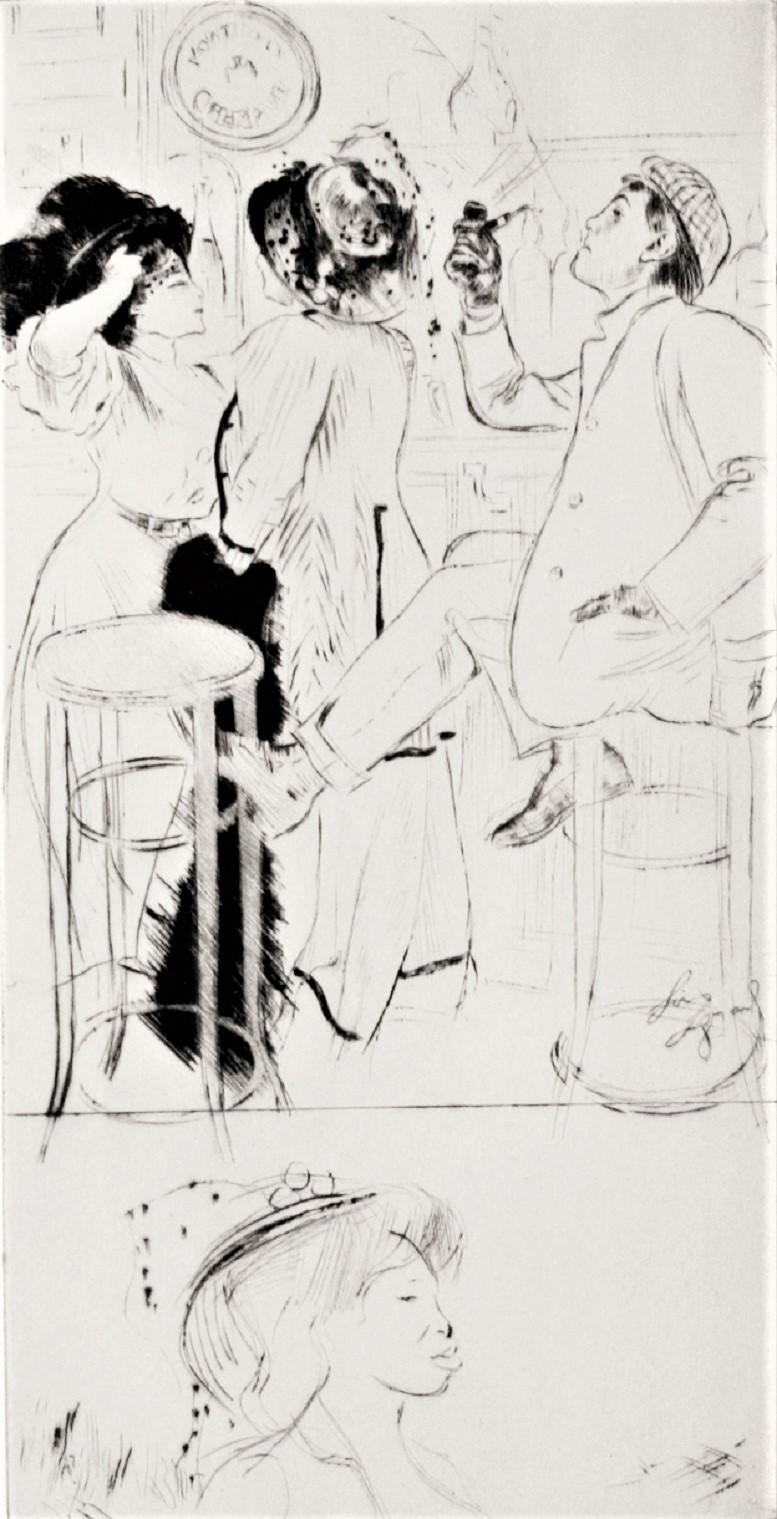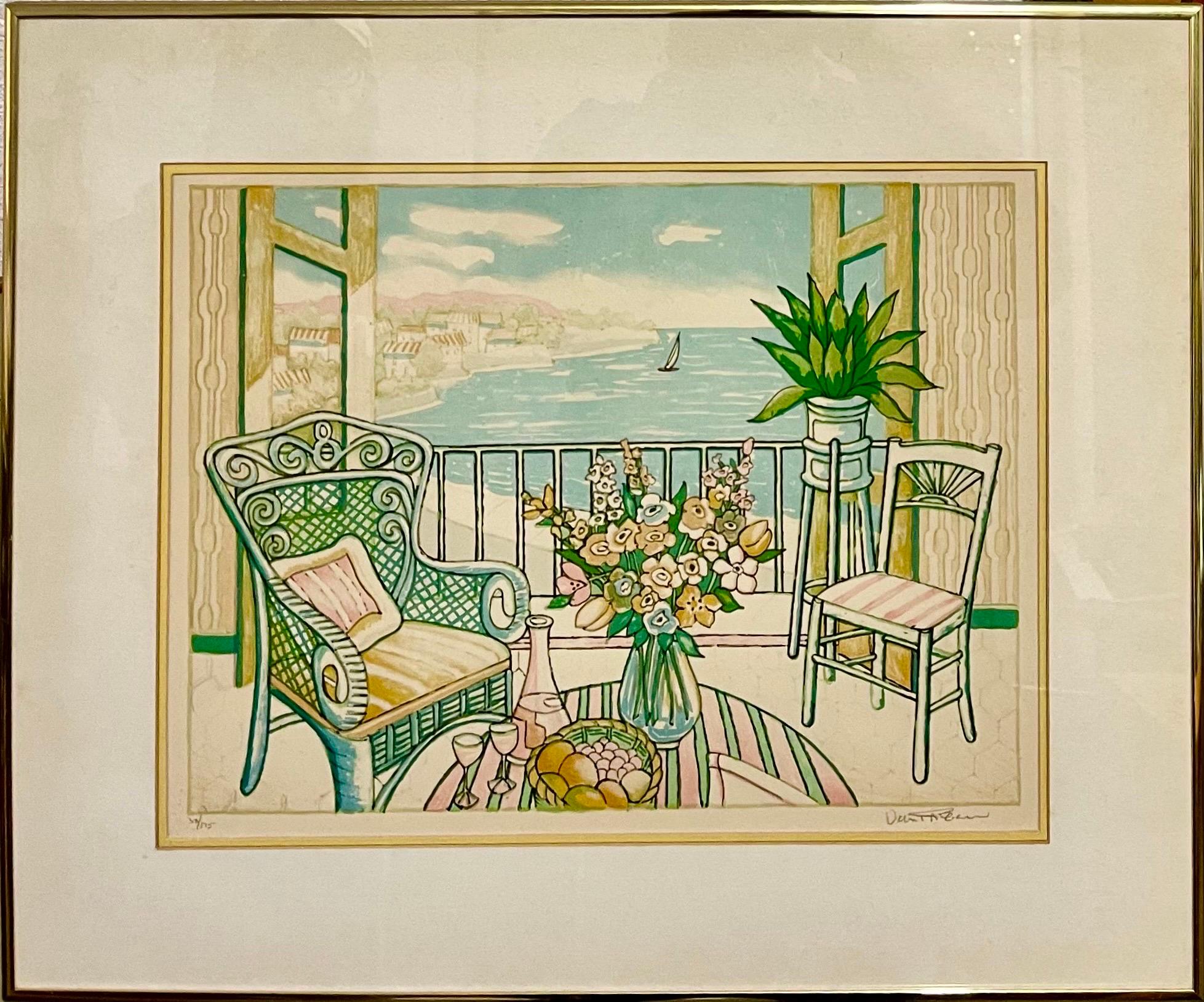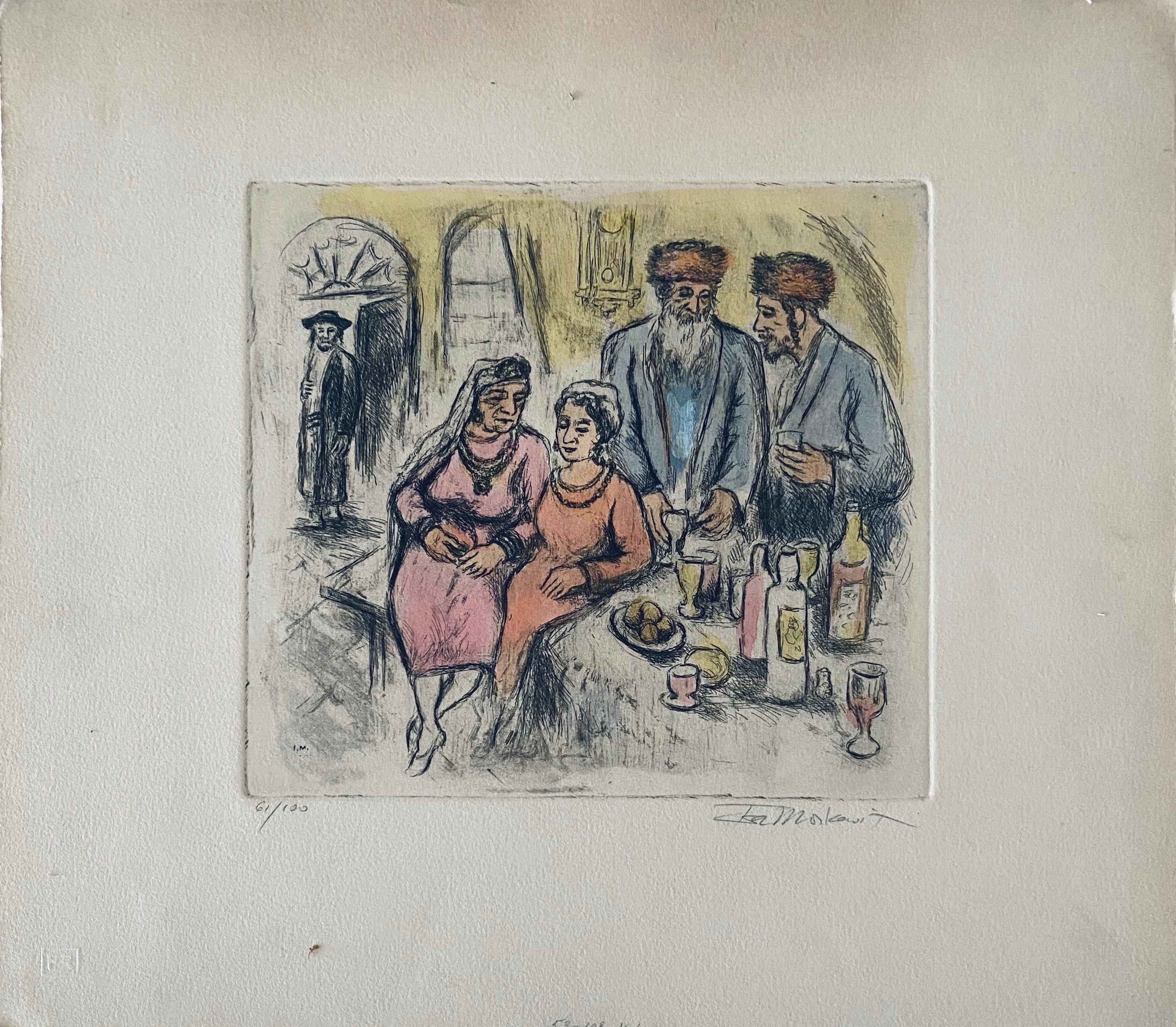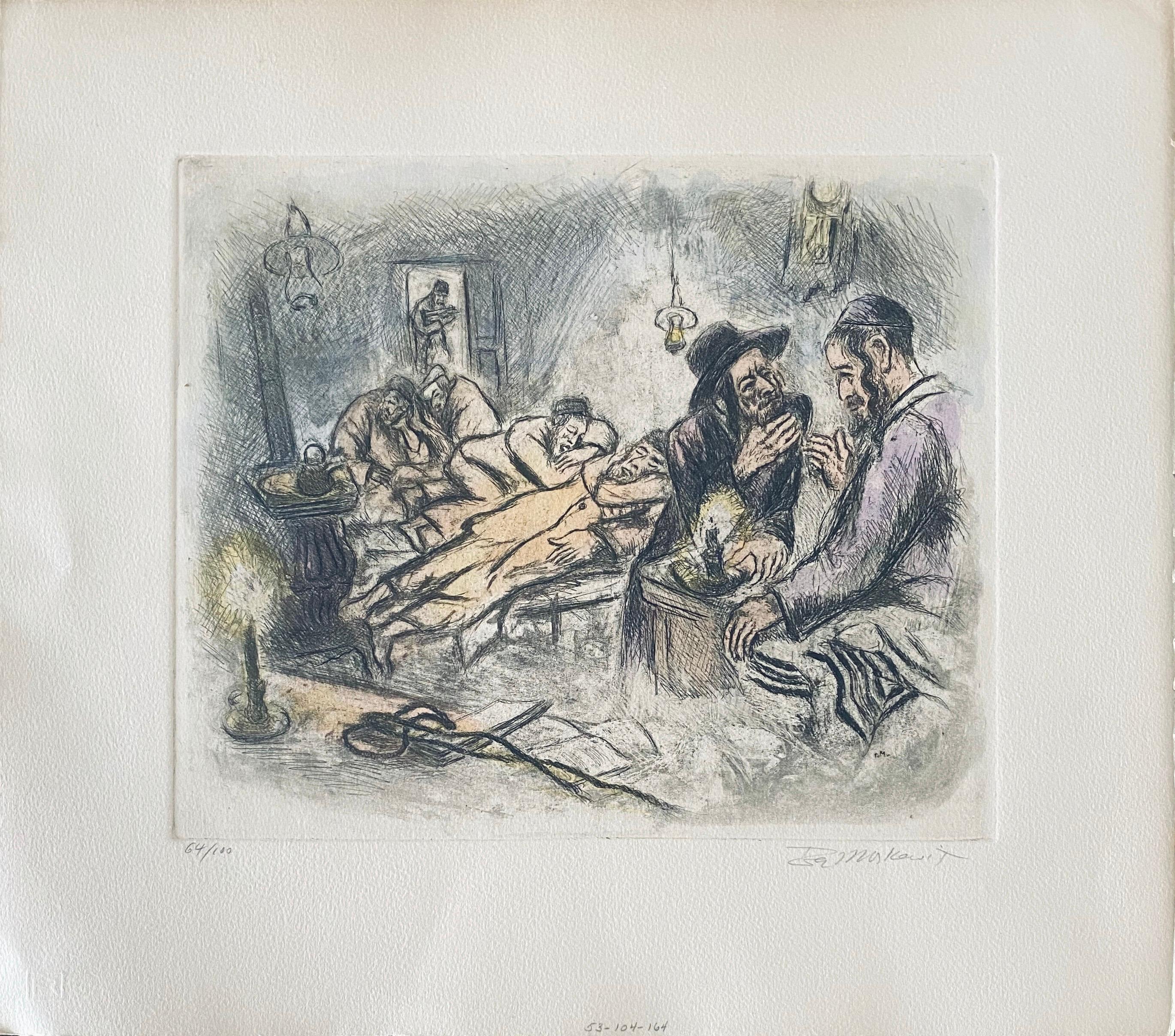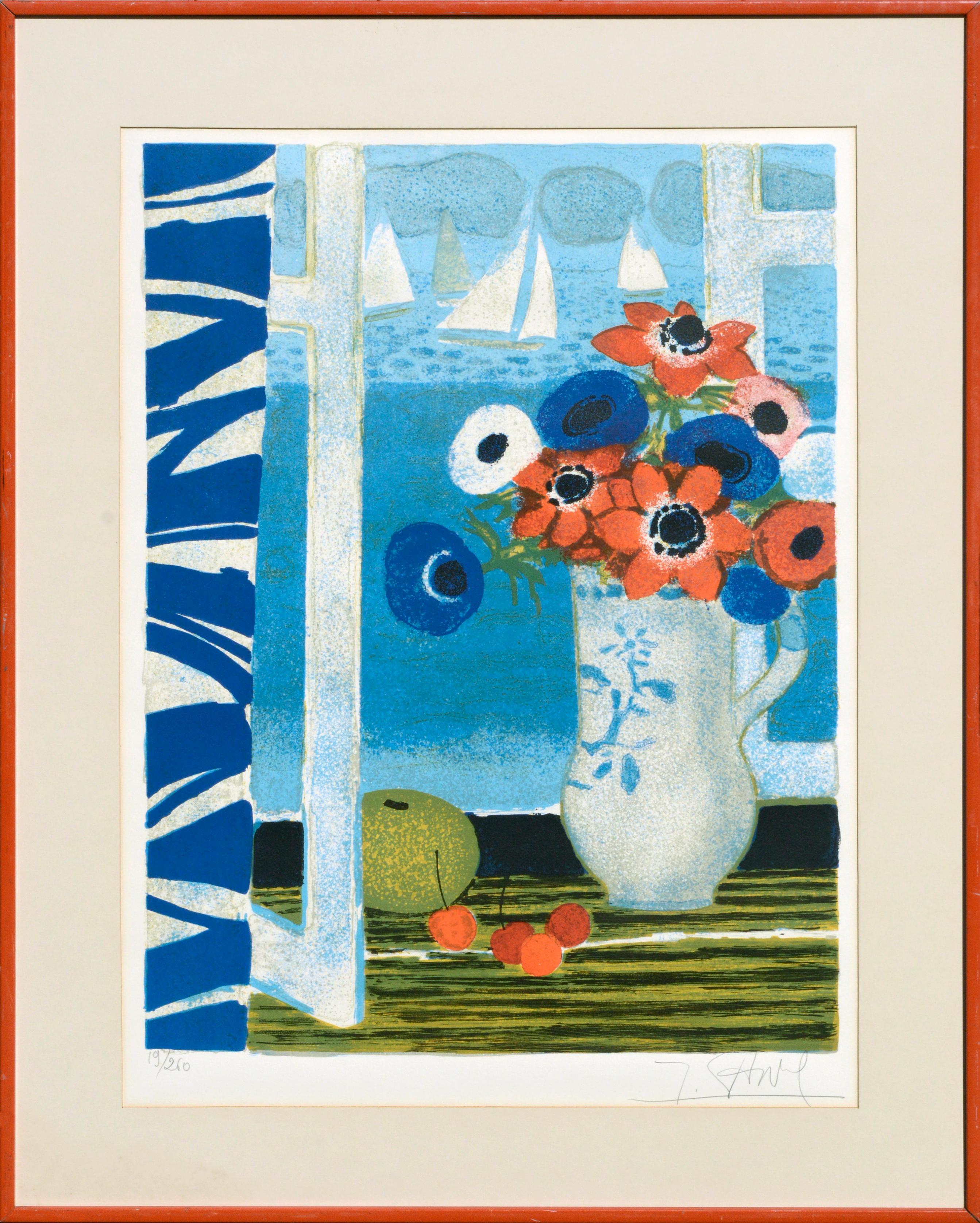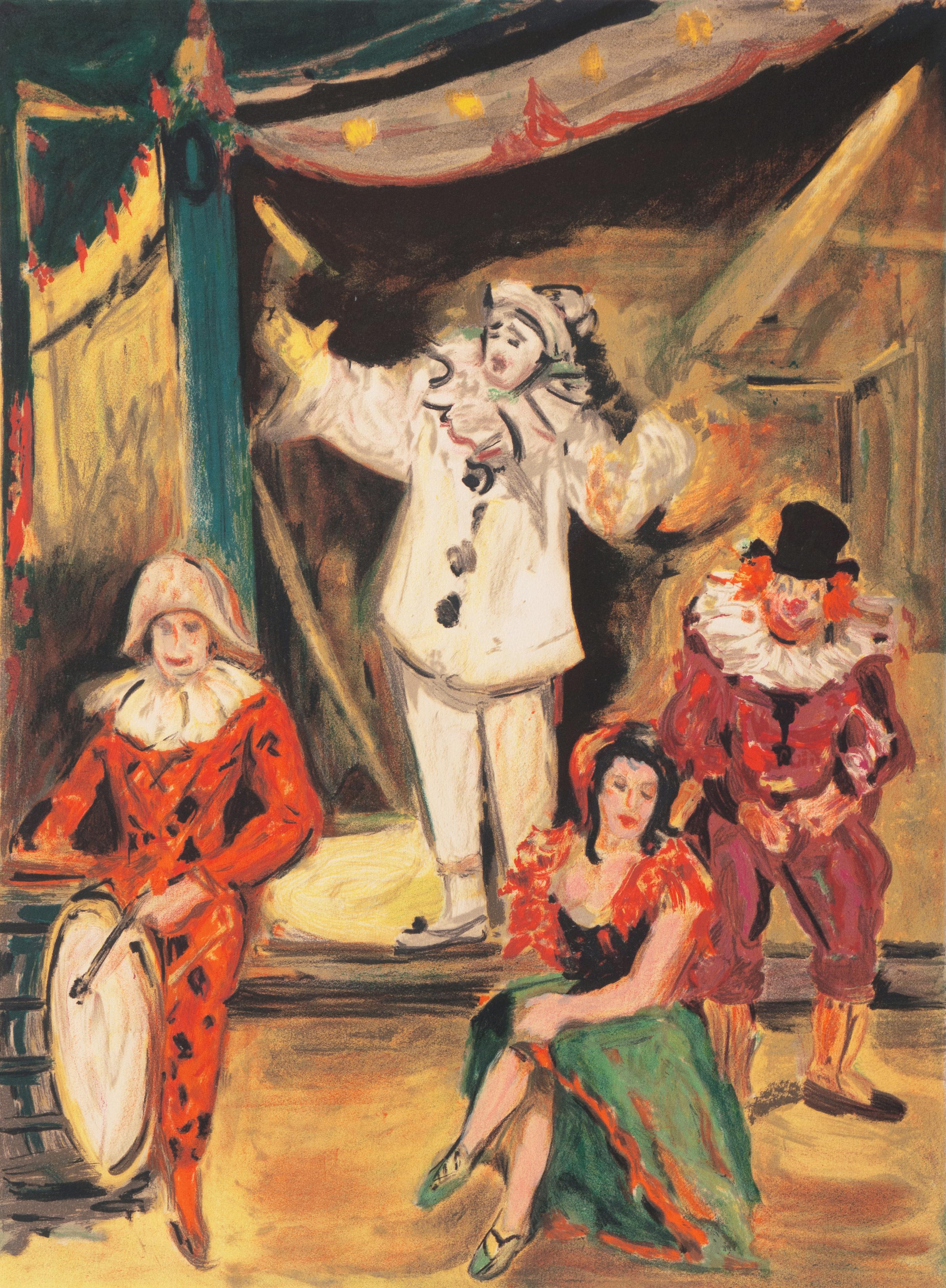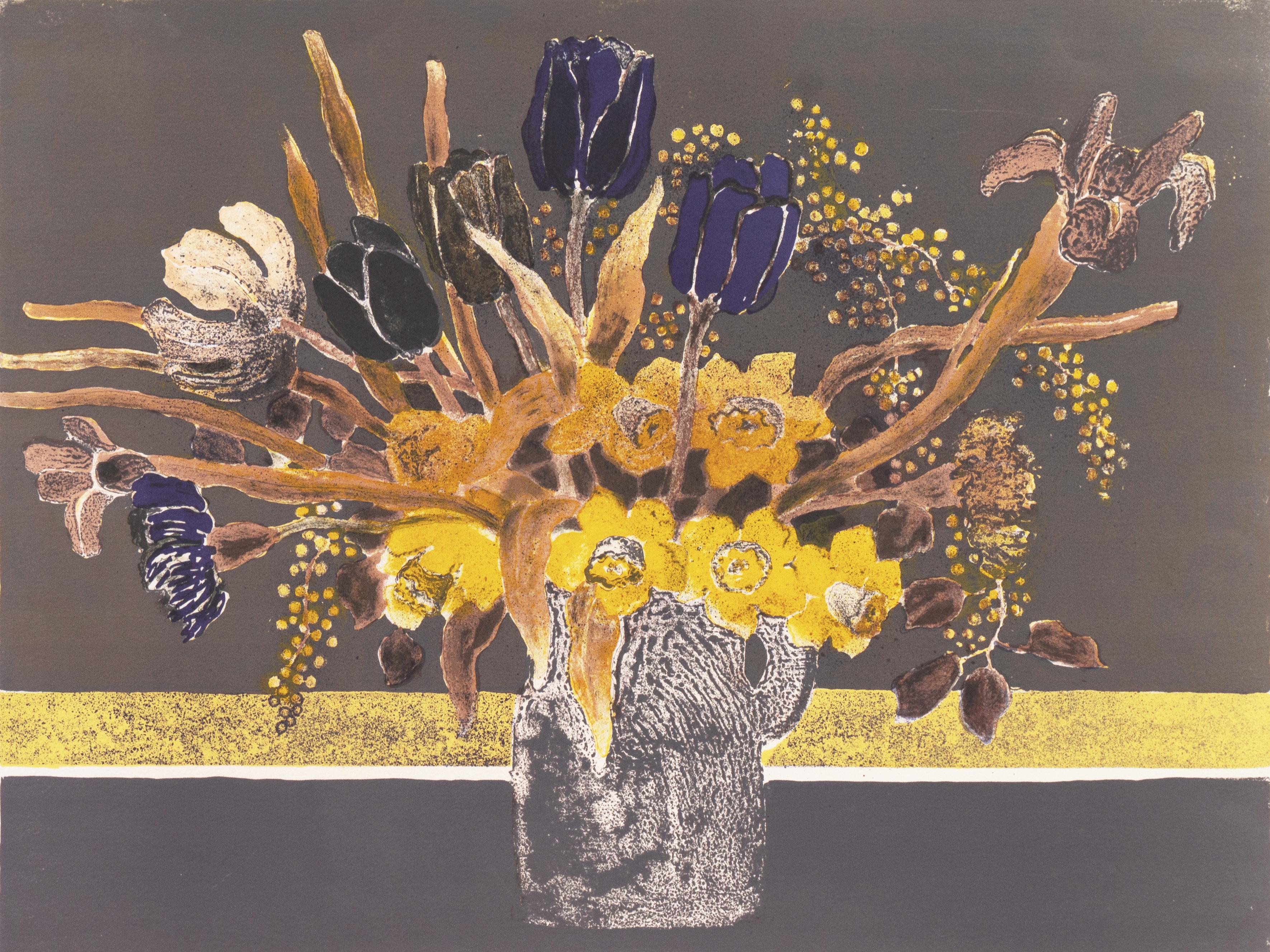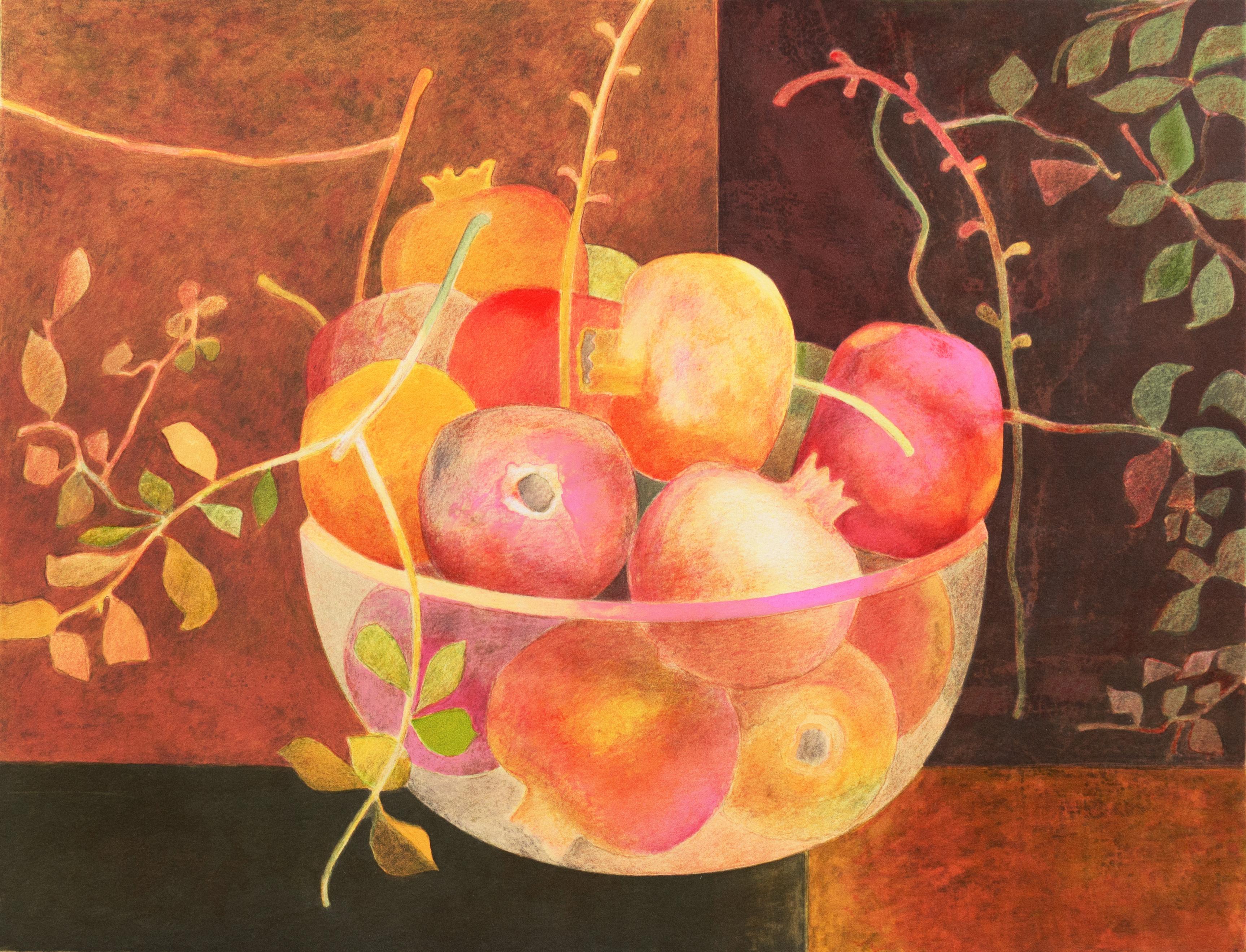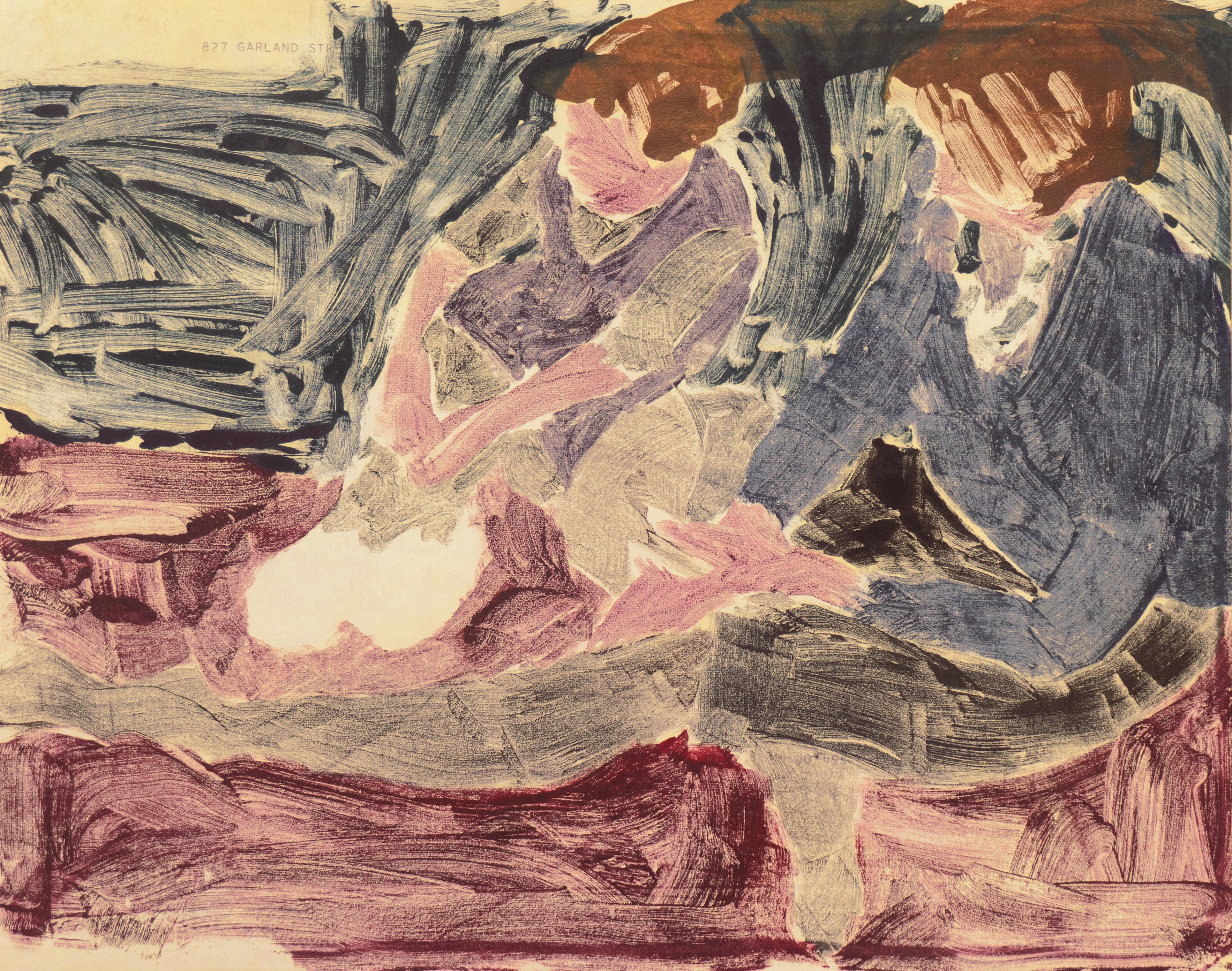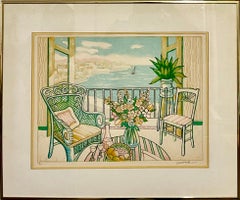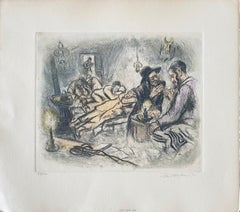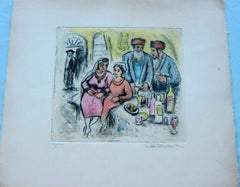
Judaica interior scene etching with hand coloring
Want more images or videos?
Request additional images or videos from the seller
1 of 8
Ira MoskowitzJudaica interior scene etching with hand coloring
About the Item
- Creator:Ira Moskowitz (1912, American)
- Dimensions:Height: 15 in (38.1 cm)Width: 17 in (43.18 cm)
- Movement & Style:
- Period:
- Condition:
- Gallery Location:Surfside, FL
- Reference Number:1stDibs: LU382116558
About the Seller
4.9
Platinum Seller
These expertly vetted sellers are 1stDibs' most experienced sellers and are rated highest by our customers.
Established in 1995
1stDibs seller since 2014
1,546 sales on 1stDibs
Typical response time: 1 hour
More From This SellerView All
- Vintage Fauvist Color Lithograph Porch Scene Jamaican Artist Van PittersonBy Lloyd Van PittersonLocated in Surfside, FLAfternoon Delight Wicker front porch chair and furniture. Framed 19 X 23 image is 13 x 17. Lloyd van Pitterson was born in Jamaica, West Indies. H...Category
20th Century Post-Impressionist Still-life Prints
MaterialsLithograph
- Judaica interior scene etching with hand coloringBy Ira MoskowitzLocated in Surfside, FLI believe the scene is of a wedding engagement. etching with extensive hand coloring (making it a unique original work of art) Ira Moskowitz (1912-2001), descendant of a long rabbinical line, was born in Galicia Poland and went with his family to Prague, Czechoslovakia, in 1914. The family remained there until 1927, and young Moskowitz received his first education in Prague's schools. Soon after, his family moved to New York City, and in 1927 Moskowitz became the pupil of Henry Wickey at the Art Students League, having finally resolved his conflict between a passion for drawing and a desire to follow the rabbinical profession of his forefathers. Between 1935 and 1938, he traveled to Israel and to Europe, Paris, France where he studied the works of the old masters, an interest derived from his first teacher and one that eventually led to his active collaboration in 1954 on the four-volume series, "Great Drawings of All Time." In 1939, Moskowitz made his first trip to Mexico, and stayed for six months. In 1943 he received a Guggenheim Fellowship and moved to New Mexico, where he remained for seven years drawing the Indians and becoming an active member of the Taos-Sante Fe artists group. It was in New York, as a student of Harry Wickey and Jerome Meyers at the Art Students League ( 1928 -32), that Moskowitz honed his talents as an artist. In the mid-to-late 1930s in Mexico, Ira was drawn to the traditions of the native peoples; in Israel, what was then British MandatePalestine he was absorbed with the religious ceremonies of the Hasidic Jews. The prints and drawings Moskowitz created in Mexico in 1941 earned him a Guggenheim Fellowship in 1943. In 1944, Ira and his wife, the artist Anna Barry moved to Taos, New Mexico. Moskowitz was entranced by New Mexico's light, landscapes, and cultures. By the time Ira arrived there, the region had already attracted Georgia O'Keeffe, Robert Henri, and Leon Gaspard...Category
20th Century Post-Impressionist Interior Prints
MaterialsLithograph
- Judaica interior scene etching with hand coloringBy Ira MoskowitzLocated in Surfside, FLEtching with extensive hand coloring (making it a unique original work of art) Ira Moskowitz (1912-2001), descendant of a long rabbinical line, was born in Galicia Poland and went with his family to Prague, Czechoslovakia, in 1914. The family remained there until 1927, and young Moskowitz received his first education in Prague's schools. Soon after, his family moved to New York City, and in 1927 Moskowitz became the pupil of Henry Wickey at the Art Students League, having finally resolved his conflict between a passion for drawing and a desire to follow the rabbinical profession of his forefathers. Between 1935 and 1938, he traveled to Israel and to Europe, Paris, France where he studied the works of the old masters, an interest derived from his first teacher and one that eventually led to his active collaboration in 1954 on the four-volume series, "Great Drawings of All Time." In 1939, Moskowitz made his first trip to Mexico, and stayed for six months. In 1943 he received a Guggenheim Fellowship and moved to New Mexico, where he remained for seven years drawing the Indians and becoming an active member of the Taos-Sante Fe artists group. It was in New York, as a student of Harry Wickey and Jerome Meyers at the Art Students League ( 1928 -32), that Moskowitz honed his talents as an artist. In the mid-to-late 1930s in Mexico, Ira was drawn to the traditions of the native peoples; in Israel, what was then British MandatePalestine he was absorbed with the religious ceremonies of the Hasidic Jews. The prints and drawings Moskowitz created in Mexico in 1941 earned him a Guggenheim Fellowship in 1943. In 1944, Ira and his wife, the artist Anna Barry moved to Taos, New Mexico. Moskowitz was entranced by New Mexico's light, landscapes, and cultures. By the time Ira arrived there, the region had already attracted Georgia O'Keeffe, Robert Henri, and Leon Gaspard...Category
20th Century Post-Impressionist Interior Prints
MaterialsEtching
- Chris Ware New Yorker Cartoonist Limited Edition Thanksgiving Print NYCBy Chris WareLocated in Surfside, FLThis is one print – printed in full color on 15" x 20" heavy cream-colored paper. It is from a limited edition series of 175, the portfolio is hand numbered and hand signed by Chris Ware. the individual prints are not. The page with the hand signature is included here as a photo for reference only it is not included in this sale. Franklin Christenson "Chris" Ware (born December 28, 1967), is an American cartoonist known for his Acme Novelty Library series (begun 1994) and the graphic novel Jimmy Corrigan, the Smartest Kid on Earth (2000) and Building Stories (2012). His works explore themes of social isolation, emotional torment and depression. He tends to use a vivid color palette and realistic, meticulous detail. His lettering and images are often elaborate and sometimes evoke the ragtime era or another early 20th-century American design style. Ware often refers to himself in the publicity for his work in self-effacing, even withering tones. He is considered by some critics and fellow notable illustrators and writers, such as Dave Eggers, to be among the best currently working in the medium; Canadian graphic-novelist Seth has said, "Chris really changed the playing field. After him, a lot of [cartoonists] really started to scramble and go, 'Holy [expletive], I think I have to try harder.'" While still a sophomore at UT, Ware came to the attention of Art Spiegelman, who invited Ware to contribute to Raw, the influential anthology magazine Spiegelman was co-editing with Françoise Mouly. Ware has acknowledged that being included in Raw gave him confidence and inspired him to explore printing techniques and self-publishing. His Fantagraphics series Acme Novelty Library defied comics publishing conventions with every issue. Ware's art reflects early 20th-century American styles of cartooning and graphic design, shifting through formats from traditional comic panels to faux advertisements and cut-out toys. Stylistic influences include advertising graphics from that same era; newspaper strip cartoonists Winsor McCay (Little Nemo in Slumberland) and Frank King (Gasoline Alley); Charles Schulz's post-WWII strip Peanuts and the cover designs of ragtime-era sheet music. Ware has spoken about finding inspiration in the work of artist Joseph Cornell and cites Richard McGuire's strip Here as a major influence on his use of non-linear narratives. He is one of the great practitioners who have elevated the graphic novel style along with, Shepard Fairey, Ben Katchor and Robert Crumb. Quimby the Mouse was an early character for Ware and something of a breakthrough. Rendered in the style of an early animation character like Felix the Cat, Quimby the Mouse is perhaps Ware's most autobiographical character. Ware's Building Stories was serialized in a host of different venues. It first appeared as a monthly strip in Nest Magazine. Installments later appeared in a number of publications, including The New Yorker, Kramer's Ergot, and most notably, the Sunday New York Times Magazine. Building Stories appeared weekly in the New York Times Magazine from September 18, 2005 until April 16, 2006. A full chapter was published in Acme Novelty Library, number 18. Another installment was published under the title "Touch Sensitive" as a digital app released through McSweeneys. The entire narrative was published as a boxed set of books by Pantheon in October 2012. Ware was commissioned by Chip Kidd to design the inner machinations of the bird on the cover of Haruki Murakami's novel The Wind-Up Bird Chronicle. In 2011, Ware created the poster for the U.S. release of the 2010 Palme d'Or winning film Uncle Boonmee Who Can Recall His Past Lives by Thai director Apichatpong Weerasethakul. Awards and honors Over the years his work garnered several awards, including the 1999 National Cartoonists Society's Award for Best Comic Book for Acme Novelty Library and Award for Graphic Novel for Building Stories. Ware has won numerous Eisner Awards and multiple Harvey Awards. In 2002, Ware became the first comics artist to be invited to exhibit at Whitney Museum of American Art biennial exhibition. With Will Eisner, Jack Kirby, Harvey Kurtzman, Robert Crumb and Gary Panter, Ware was among the artists honored in the exhibition "Masters of American Comics" at the Jewish Museum in New York City, New York, from September 16, 2006 to January 28, 2007. His work was the subject of solo exhibitions at the Museum of Contemporary Art, Chicago in 2006 and at the University of Nebraska's Sheldon Museum of Art, in 2007. Many famous artists have done covers for the New Yorker Magazine including, Saul Steinberg, Maira Kalman, Art Spiegelman, Francoise Mouly, Charles Addams, Peter Arno, Roz Chast, Ed Koren...Category
Early 2000s American Modern Figurative Prints
MaterialsColor
- Chris Ware New Yorker Cartoonist Limited Edition Thanksgiving Print NYCBy Chris WareLocated in Surfside, FLThis is one print – printed in full color on 15" x 20" heavy cream-colored paper. It is from a limited edition series of 175, the portfolio is hand numbered and hand signed by Chris Ware. the individual prints are not. The page with the hand signature is included here as a photo for reference only it is not included in this sale. Franklin Christenson "Chris" Ware (born December 28, 1967), is an American cartoonist known for his Acme Novelty Library series (begun 1994) and the graphic novel Jimmy Corrigan, the Smartest Kid on Earth (2000) and Building Stories (2012). His works explore themes of social isolation, emotional torment and depression. He tends to use a vivid color palette and realistic, meticulous detail. His lettering and images are often elaborate and sometimes evoke the ragtime era or another early 20th-century American design style. Ware often refers to himself in the publicity for his work in self-effacing, even withering tones. He is considered by some critics and fellow notable illustrators and writers, such as Dave Eggers, to be among the best currently working in the medium; Canadian graphic-novelist Seth has said, "Chris really changed the playing field. After him, a lot of [cartoonists] really started to scramble and go, 'Holy [expletive], I think I have to try harder.'" While still a sophomore at UT, Ware came to the attention of Art Spiegelman, who invited Ware to contribute to Raw, the influential anthology magazine Spiegelman was co-editing with Françoise Mouly. Ware has acknowledged that being included in Raw gave him confidence and inspired him to explore printing techniques and self-publishing. His Fantagraphics series Acme Novelty Library defied comics publishing conventions with every issue. Ware's art reflects early 20th-century American styles of cartooning and graphic design, shifting through formats from traditional comic panels to faux advertisements and cut-out toys. Stylistic influences include advertising graphics from that same era; newspaper strip cartoonists Winsor McCay (Little Nemo in Slumberland) and Frank King (Gasoline Alley); Charles Schulz's post-WWII strip Peanuts and the cover designs of ragtime-era sheet music. Ware has spoken about finding inspiration in the work of artist Joseph Cornell and cites Richard McGuire's strip Here as a major influence on his use of non-linear narratives. He is one of the great practitioners who have elevated the graphic novel style along with, Shepard Fairey, Ben Katchor and Robert Crumb. Quimby the Mouse was an early character for Ware and something of a breakthrough. Rendered in the style of an early animation character like Felix the Cat, Quimby the Mouse is perhaps Ware's most autobiographical character. Ware's Building Stories was serialized in a host of different venues. It first appeared as a monthly strip in Nest Magazine. Installments later appeared in a number of publications, including The New Yorker, Kramer's Ergot, and most notably, the Sunday New York Times Magazine. Building Stories appeared weekly in the New York Times Magazine from September 18, 2005 until April 16, 2006. A full chapter was published in Acme Novelty Library, number 18. Another installment was published under the title "Touch Sensitive" as a digital app released through McSweeneys. The entire narrative was published as a boxed set of books by Pantheon in October 2012. Ware was commissioned by Chip Kidd to design the inner machinations of the bird on the cover of Haruki Murakami's novel The Wind-Up Bird Chronicle. In 2011, Ware created the poster for the U.S. release of the 2010 Palme d'Or winning film Uncle Boonmee Who Can Recall His Past Lives by Thai director Apichatpong Weerasethakul. Awards and honors Over the years his work garnered several awards, including the 1999 National Cartoonists Society's Award for Best Comic Book for Acme Novelty Library and Award for Graphic Novel for Building Stories. Ware has won numerous Eisner Awards and multiple Harvey Awards. In 2002, Ware became the first comics artist to be invited to exhibit at Whitney Museum of American Art biennial exhibition. With Will Eisner, Jack Kirby, Harvey Kurtzman, Robert Crumb and Gary Panter, Ware was among the artists honored in the exhibition "Masters of American Comics" at the Jewish Museum in New York City, New York, from September 16, 2006 to January 28, 2007. His work was the subject of solo exhibitions at the Museum of Contemporary Art, Chicago in 2006 and at the University of Nebraska's Sheldon Museum of Art, in 2007. Many famous artists have done covers for the New Yorker Magazine including, Saul Steinberg, Maira Kalman, Art Spiegelman, Francoise Mouly, Charles Addams, Peter Arno, Roz Chast, Ed Koren...Category
Early 2000s American Modern Figurative Prints
MaterialsColor
- Girl in Ballerina Dress (Thonet Chair) Color Lithograph, American ModernistBy Philip PearlsteinLocated in Surfside, FLGirl in Ballerina Dress, c. 1970 Color lithograph printed on wove paper, hand signed in pencil and numbered 22/75, with the inkstamp of the publisher, Landfall Press, Chicago (they have published an eclectic list of many important artists including Christo, Judy Chicago, David Levinthal and Jack tworkov to name a few.) Philip Pearlstein is an influential American painter best known for Modernist Realism nudes. Cited by critics as the preeminent figure painter of the 1960s to 2000s, he led a revival in realist art. He is a Distinguished Professor Emeritus with paintings in the collections of over 70 public art museums. Philip M. Pearlstein was born on May 24, 1924 in Pittsburgh, PA. He attended Saturday morning classes at Pittsburgh's Carnegie Museum of Art. In 1942, at the age of 18, two of his paintings won a national competition sponsored by Scholastic Magazine, and were reproduced in color in Life magazine. In 1942, he enrolled at Carnegie Institute of Technology's art school, in Pittsburgh, where he painted two portraits of his parents now held by the Carnegie Museum of Art, but after one year he was drafted by the US Army to serve during World War II. He was initially assigned to the Training Aids Unit at Camp Blanding, Florida, where he produced charts, weapon assembly diagrams and signs. In this role, he learned printmaking and the screenprinting process, and subsequently was stationed in Italy making road signs. While in Italy, he took in as much renaissance art as was accessible in Rome, Florence, Venice and Milan, and also produced numerous drawings depicting life in the Army. In 1946, sponsored by the GI Bill, he returned to Carnegie Institute, and first met Andy Warhol, who was attracted to Pearlstein because of his notoriety in the school, having been featured in Life magazine. During the summer of 1947, the three rented a barn as a summer studio. Immediately after graduating in June 1949 with a BFA, Pearlstein and Warhol moved to New York City, at first sharing an eighth-floor walkup tenement apartment on St. Mark's Place at Avenue A. He was eventually hired by Czech designer Ladislav Sutnar, mainly doing industrial catalog work, while Warhol immediately found work illustrating department store catalogs presaging Pop Art. In April 1950, they moved to 323 W. 21st Street, into an apartment rented by Franziska Marie Boas, who ran a dance class on the other side of the room. During this time, Pearlstein painted a portrait of Warhol, now held by the Whitney Museum of American Art. In 1950, Philip Pearlstein married Dorothy Cantor, with Andy Warhol in the wedding party...Category
1970s American Realist Figurative Prints
MaterialsLithograph
You May Also Like
- SportsmenBy Louis LegrandLocated in Storrs, CTSportsmen. 1908. Etching and drypoint. Exsteens 271.i/ii. 11 1/4 x 5 3/4 (sheet 17 3/8 x 12 1/4). Series: Les Bars. From the first state edition of 30 proofs with the remarque sketch...Category
Early 1900s Post-Impressionist Figurative Prints
MaterialsDrypoint, Etching
$875 Sale Price50% Off - View on the Artist Workshop - Stone lithograph - Mourlot 1982By Jules CavaillesLocated in Paris, FRJules CAVAILLES View on the Artist Workshop Original stone lithograph in colors (printed in atelier Mourlot) Numbered / 200 On Arches vellum 76 x 56 ...Category
1980s Post-Impressionist Interior Prints
MaterialsLithograph
- Flowers and Fruit in Front of the Window Still Life- School of ParisBy Yves GanneLocated in Soquel, CABrightly colored lithograph still-life by Yves Ganne (French, b. 1931). Signed "Y. Ganne" in the lower right corner. Numbered "19/260" in the lower left corner. Presented in a tan ma...Category
Late 20th Century Post-Impressionist Still-life Prints
MaterialsPaper, Ink, Screen
- "La Conversation" Large original lithographBy Jean-Pierre CassigneulLocated in San Francisco, CAThis art work titled "La Conversation" 1991 is an original color lithograph on wove paper by French artist, Jean Pierre Cassigneul, born 1935. It is h...Category
Late 20th Century Post-Impressionist Figurative Prints
MaterialsLithograph
- 'Pierrot's Lament', Post-Impressionist, Paris Salon, Centre Pompidou, NY MoMABy Arbit BlatasLocated in Santa Cruz, CASigned lower right, 'Arbit Blatas' (Lithuanian, 1908-1999) and with number and limitation, '123/195', lower left. Lithuanian born, Arbit Blatas first studied in Paris at the Academie de la Grande Chaumiere and, subsequently, at the Academie Julian. He was a member of the Salon d'Automne where he also exhibited. Other exhibition venues included the Carnegie Institute, the Pennsylvania Academy, the Santa Barbara Museum and the Rhode Island School of Design. An artist of great range, his vivid colors and joie de vivre extend through his entire canon of paintings: landscapes, portraits and still-lives. The distinguished French art critic, Jean Bouret, summed the artist up in this way: "He is color, his palette is color, exuberant and sensual, as is the man." On the other end of Blatas' artistic spectrum, the noted Italian art historian Enzo di Martini wrote of the Monument of the Holocaust: "In complete contrast to his paintings, these bronzes are hammered and chiseled in anger and tragedy." In 1929 he began to exhibit regularly at the Salon D'Automne and the Salon des Tuileries in Paris. At the age of twenty-one, he became the youngest member of the School of Paris and a friend and colleague to many of the great figures in the Parisian art world such as Vlaminck, Utrillo, Soutine, Picasso, Derain and Matisse. Blatas eventually painted or sculpted them all and his forty-nine portraits in oil and bronze are considered a unique document of that period in Paris. The artist exhibited regularly in the principal galleries of New York, Paris and London. His works are also included in some of the most valued private international art collections. Sheet dimensions: 25.5 x 19 inches. Partial List of Exhibitions: NEW YORK - Pierre Matisse Gallery; Associated American Artists; French Art Gallery; Bignou Gallery; Fine Arts Associates; Hirschl & Adler Galleries, Inc.; Eastlake Gallery; Beacon Hill Fine Arts Gallery PARIS - Galerie Zborowski; Salon D'Automne; Salon des Tuileries; Galerie Mouradian-Van Leer; Galerie Mouradian-Vallotton; Salon Populiste; Galerie de l'Elysée; Galerie André Weil; Galerie Bernheim-Jeune; Galerie René Drouet LONDON - Wildenstein Gallery; Grosvenor Gallery; Archer Gallery; Fine Arts Society; Redfern Gallery VENICE - Gritti Palace; Chiesa di San Samuele; Teatro Goldoni; Galleria Graziussi; Chiesa San Stae TREVISO - Teatro Comunale LAUSANNE - Galerie Vallotton TORONTO - Goethe Institute MONTREAL - Gallery Moos SYDNEY - Holdsworth Gallery. Partial List of Collections: USA - Metropolitan Museum of Art, New York; Museum of Modern Art, New York; Whitney Museum of American Art, New York; Museum of the City of New York; National Portrait Gallery; the Smithsonian Institution; Carnegie Institute, Pittsburgh; Rochester Museum; Virginia Museum; Delgado Museum, New Orleans; Palm Springs Desert Museum; Wichita Art Museum FRANCE - Jeu de Paume, Paris; Le Centre Pompidou...Category
Mid-20th Century Post-Impressionist Interior Prints
MaterialsLithograph, Paper
$2,200 Sale Price20% Off - 'Still Life of Tulips and Orchids', Academie Chaumiere, MAM Paris, BenezitBy Pierre Garcia FonsLocated in Santa Cruz, CASigned lower right, 'Garcia Fons' for Pierre Garcia-Fons (French, 1928-2016), and inscribed lower left with edition number and limitation, '80/80'; also inscribed, lower left, 'Garci...Category
1970s Post-Impressionist Still-life Prints
MaterialsLaid Paper, Lithograph
$1,160 Sale Price20% Off
